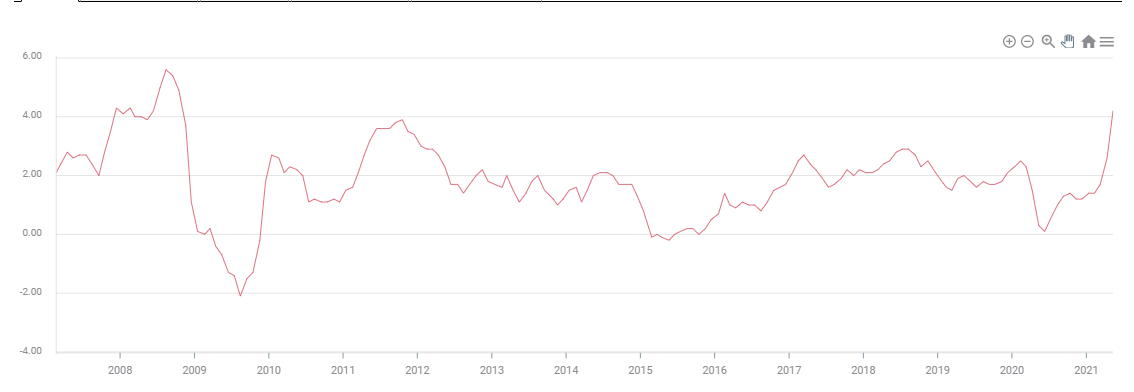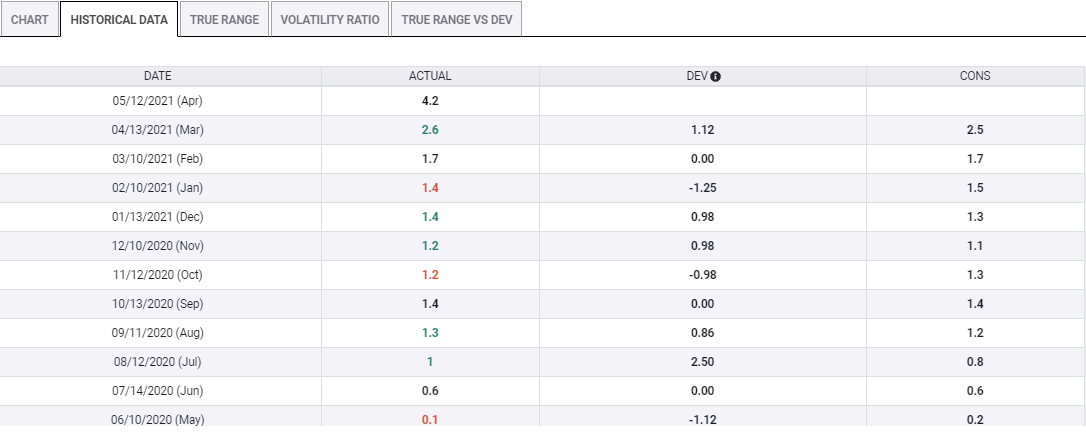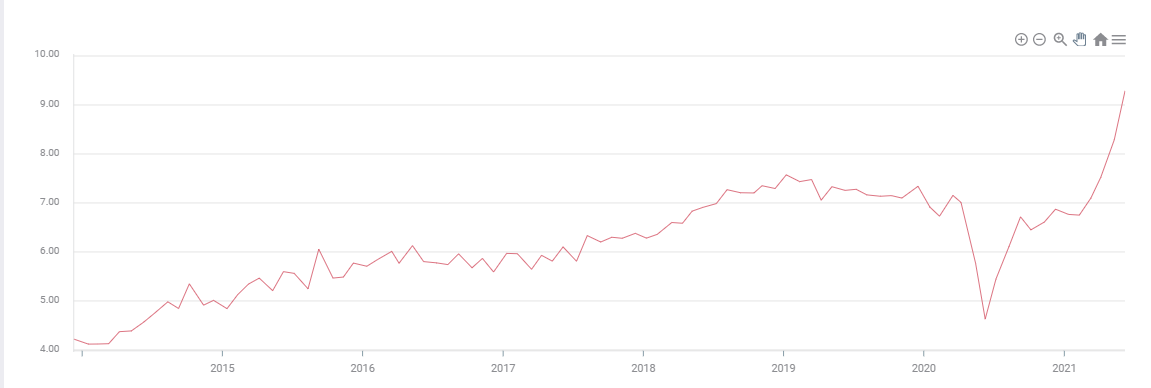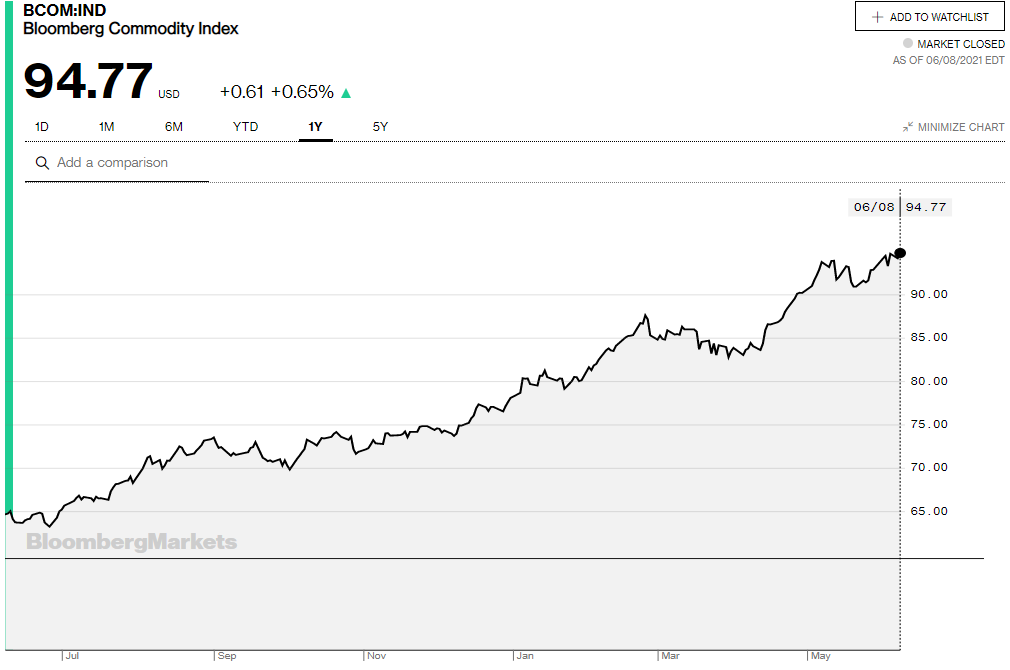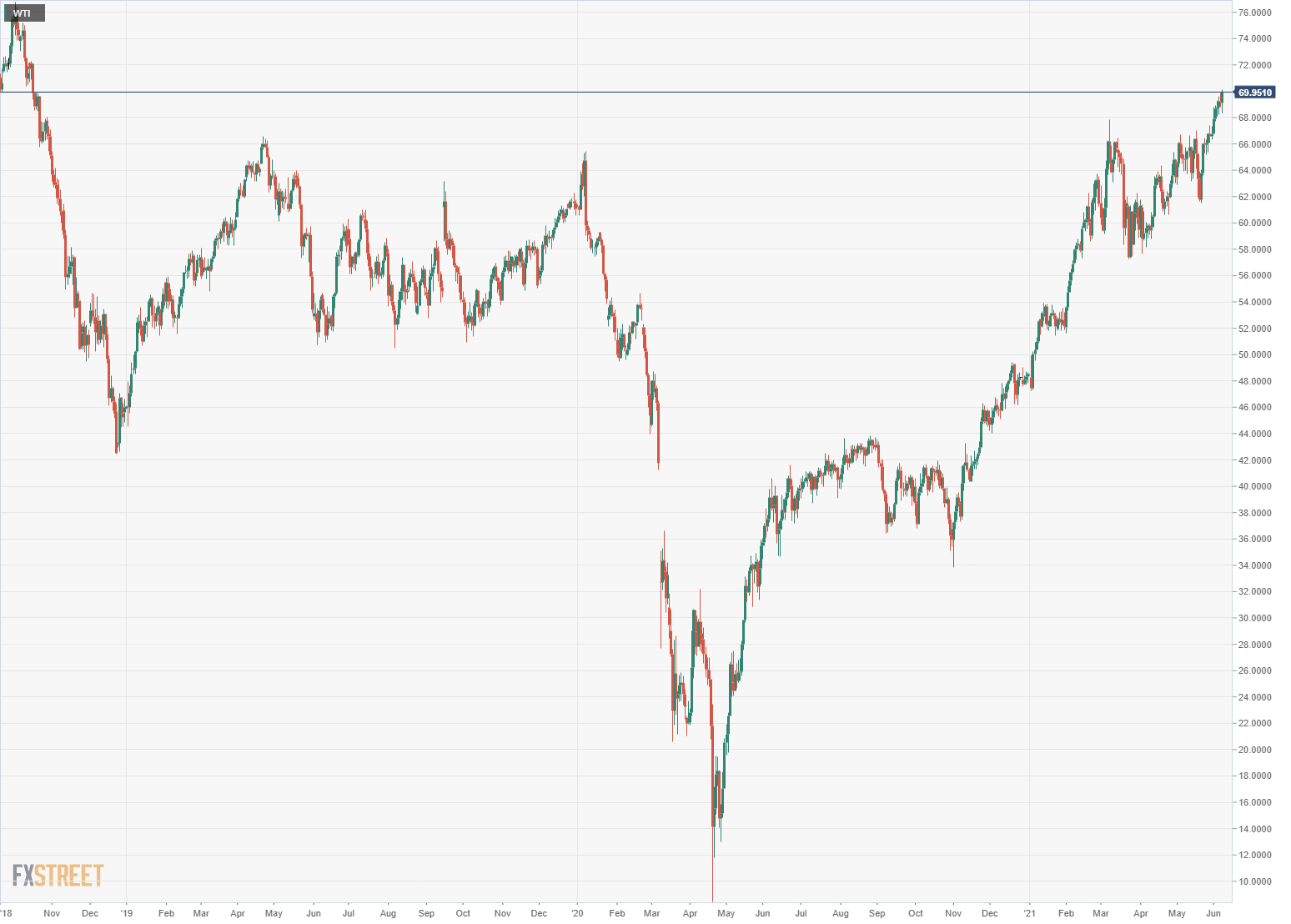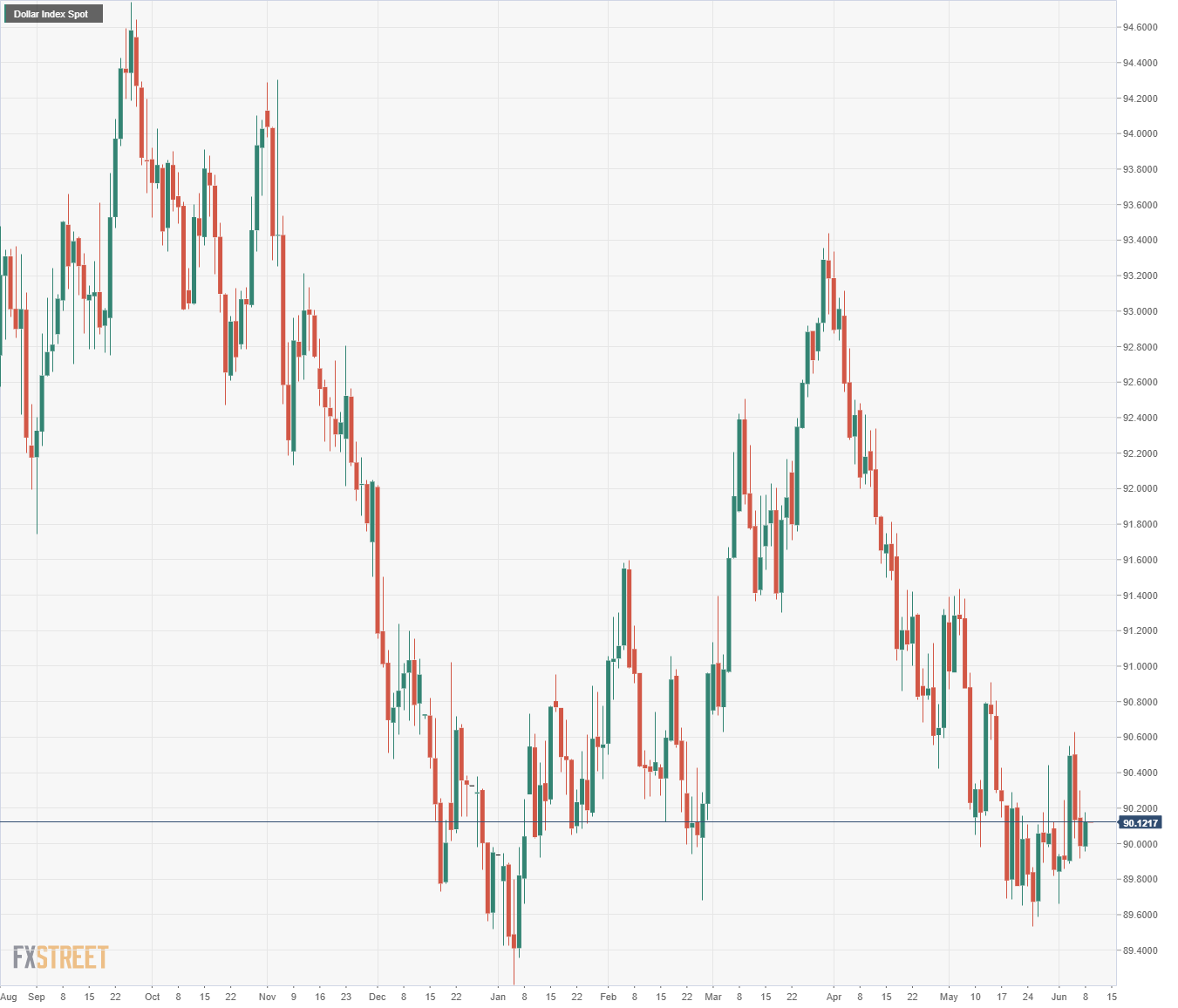- Annual CPI forecast to climb to 4.7%, core to 3.4% in May.
- Federal Reserve interest rate policy tied to labor market recovery.
- Inflation stirring in commodities, product shortages and wages.
- Fed seems to have begun market preparation for bond taper.
- US dollar is a reflection of Treasury rates.
When the Federal Reserve moved its price measurement to inflation averaging last September the governors were carefully insulating rate policy from this year’s expected acceleration in consumer costs.
The governors did not want their pandemic rate accommodation pressured by the traditional credit market approach to inflation which often anticipates the Fed’s own policy adjustment by many months.
The Fed’s defensive preparation was warranted.
This year annual inflation has tripled in four months, from 1.4% in January to 4.2% in April.
The Consumer Price Index (CPI) is forecast to rise 0.4% in May, after gaining 0.8% in April. The annual rate is expected to reach 4.7% from 4.2% in April. Core CPI is predicted to add 0.4% in May after April’s 0.9% increase and the yearly core rate is projected to rise to 3.4% from 3% prior.
CPI
FXStreet
Inflation: Lockdown prices
Consumer prices collapsed last spring. Americans stopped buying except for food and essentials and retreated into their homes. The economic recovery and accompanying demand surge this year has produced the predictable inflation spike that the Fed anticipated.
Annual CPI has increased sharply since the beginning of the year. From January to February it rose 0.3%, from February to March 0.9% and from March to April 1.6%.
The largest increase in annual CPI this year from March’s 2.6% to April’s 4.2%, mirrored the drop a year earlier, from 1.5% in March to 0.3% in April.
CPI
FXStreet
If the May forecast of 4.7% is correct, the base effect has begun to subside. The increase of 0.5% from April to May will be less than a third of the gain one month earlier.
The Fed’s calculation that once the distortion of the lockdown price plunge had passed inflation would resume a normal, and much shallower, upward curve is probably correct. The question for the rest of the year is how much has the underlying inflation rate changed?
In the second half of 2019 CPI averaged 1.9% annually.
The economic forces that have been gathering this past year will keep inflation above last year’s average. How much above is the known unknown.
Inflation: Labor markets, commodities, and shortages
Inflation will not return to its pre-pandemic range because the US and global economies are far from normal.
Labor markets remain strained in the US. A record 9.3 million jobs were untaken in April in the Job Openings and Turnover Survey (JOLTS), an increase of almost one million from March.
JOLTS
With hiring dismal in April and anemic in May considering the number of positions open, employers are offering wages increases and signing bonuses. The cause of worker reluctance is probably the extended federal unemployment benefits. If so then the extra compensation may fade as the program ends in September.
The long term effect of higher wages is unknown but wages are particularly sticky. It is difficult for one firm to lower compensation in a tight labor market when other companies continue to pay at higher rates. There is a good chance that the higher pay scales are permanent.
Commodities are another ingredient in price movement. The Bloomberg Commodity Index (BCOM) is up 23.9% since the close on December 28 last year. It is 57.3% higher than the pandemic bottom on April 24, 2020.
BCOM
West Texas Intermediate (WTI) has gained 47.6% since January 4. It is 119.5% higher than its May19, 2020 finish at $31.93.
Oil is not just the industrialized world's premier commodity with participation in almost every facet of modern production. Oil prices transfer directly and immediately to the consumer. The nationwide average for a gallon of regular gasoline was $2.94 on June 6, 36.1% higher than its price on December 28 last year.
WTI
Finally, production delays and component and raw material shortages, primarily computer chips, have curtailed manufacturing for many and varied consumer products. Prices have consequently gone up for a wide array of consumer and food items.
For the past 25 or 30 years globalization and the worldwide supply chain have kept a lid on consumer prices..
These lockdown-induced shortages and disruptions have affected factories around the world. There are no cheaper goods to sell, in some cases there are no goods at all. Pricing power has returned to many manufacturers and retailers.
The labor and product shortages will eventually ease but not before many months of further increases. Commodity prices depend on demand and that looks to be strong through the end of the year.
While the upward pressure on these categories may diminish, their input into the cost of goods and services should ensure the highest inflation rate in a decade and it should remain so into next year.
Inflation: Federal Reserve Rate policy
The Federal Reserve has tied its monetary policy to a complete labor market recovery.
Payrolls in April and May, barely half of expectations, have damped what had appeared to be a rush back to full employment.
The Biden administration has complicated the picture by extending unemployment insurance through September. This seems to be retarding hiring, or perhaps it is more accurate to say, to be dissuading some workers from looking for a job.
Treasury rates rose sharply in the first quarter as markets speculated that the US economy would accelerate. In all aspects except the labor market that has been true.
Growth has exploded from 6.4% annualized in the first quarter to an estimated 9.4% from the Atlanta Fed in the second. Purchasing Managers’ Indexes for services and manufacturing are, except for employment, uniformly strong. Managers note the difficulty of finding and employing workers rather than not having jobs to offer.
The fast healing US economy has prompted the Fed to begin the preparation for a reduction and conclusion to its bond purchase program. The $120 billion a month of Treasuries and mortgage assets bought by the Fed each month has kept the short end of the yield curve pinned near historical lows.
Minutes from the April meeting mentioned that some of the members thought the time for discussing the bond program might be approaching. A number of other Fed and government officials, including Treasury Secretary Janet Yellen, have voiced similar opinions.
The April and May payrolls have temporarily squelched the credit market's rate speculation on the taper, if they have not silenced all public consideration by Fed members.
Inflation has complicated the rate picture. Even after the base effect disappears, inflation is going to be sharply higher this year.
Inflation averaging, the Fed’s policy of letting prices rise for a period beyond the 2% target to produce an acceptably higher rate, has eliminated the need to respond immediately to consumer prices.
However, if inflation becomes a widespread and continuing phenomenon, the Fed will have to answer. Bond traders can make that almost mandatory.
The US economy will later or sooner force Treasury rates above 2%, even if inflation does not move above 3% permanently. Fed policy is preparing for this eventuality.
DXY and the dollar
The Dollar Index, and the greenback in general, followed US Treasury rates higher in the first quarter.
From January 6 to March 30 the Dollar Index rose 4.3% to 93.29.
The correlation with the 10-year Treasury rate on the turn was nearly exact. The 10-year Treasury yield climbed 83 basis points from December 31 to March 31, 0.916% to 1.74605. Treasury yields turned south on April 1 and this benchmark rate has not closed as high since.
US 10-year Treasury yield
CNBC
Interestingly, the Dollar Index has lost almost all of its 2021 gains, closing at 90.12 on Tuesday. The 10-year yield has retained 75% of its first quarter rise, ending at 1.534% on Tuesday. This is another indication that the credit market expects higher US interest rates.
Conclusion
Treasury yields have been the interface between the US economy and currency values.
To the degree that CPI changes perceptions of future Federal Reserve policy, higher inflation can push the dollar higher. Interest rates remain, as they have always been, the strongest factor in currency direction.
Once the base effect of last year’s lockdown is ended, CPI increases will exert a stronger influence on market perceptions and Fed policy.
It is not yet time for inflation to resume its historical primacy in Fed policy. The incomplete rebound in the labor market stands in the way.
If at the end of the third quarter inflation is still running at more than 3%, it will swiftly become a central policy and market concern.
Information on these pages contains forward-looking statements that involve risks and uncertainties. Markets and instruments profiled on this page are for informational purposes only and should not in any way come across as a recommendation to buy or sell in these assets. You should do your own thorough research before making any investment decisions. FXStreet does not in any way guarantee that this information is free from mistakes, errors, or material misstatements. It also does not guarantee that this information is of a timely nature. Investing in Open Markets involves a great deal of risk, including the loss of all or a portion of your investment, as well as emotional distress. All risks, losses and costs associated with investing, including total loss of principal, are your responsibility. The views and opinions expressed in this article are those of the authors and do not necessarily reflect the official policy or position of FXStreet nor its advertisers. The author will not be held responsible for information that is found at the end of links posted on this page.
If not otherwise explicitly mentioned in the body of the article, at the time of writing, the author has no position in any stock mentioned in this article and no business relationship with any company mentioned. The author has not received compensation for writing this article, other than from FXStreet.
FXStreet and the author do not provide personalized recommendations. The author makes no representations as to the accuracy, completeness, or suitability of this information. FXStreet and the author will not be liable for any errors, omissions or any losses, injuries or damages arising from this information and its display or use. Errors and omissions excepted.
The author and FXStreet are not registered investment advisors and nothing in this article is intended to be investment advice.
Recommended Content
Editors’ Picks

EUR/USD stays near 1.0400 in thin holiday trading
EUR/USD trades with mild losses near 1.0400 on Tuesday. The expectation that the US Federal Reserve will deliver fewer rate cuts in 2025 provides some support for the US Dollar. Trading volumes are likely to remain low heading into the Christmas break.

GBP/USD struggles to find direction, holds steady near 1.2550
GBP/USD consolidates in a range at around 1.2550 on Tuesday after closing in negative territory on Monday. The US Dollar preserves its strength and makes it difficult for the pair to gain traction as trading conditions thin out on Christmas Eve.

Gold holds above $2,600, bulls non-committed on hawkish Fed outlook
Gold trades in a narrow channel above $2,600 on Tuesday, albeit lacking strong follow-through buying. Geopolitical tensions and trade war fears lend support to the safe-haven XAU/USD, while the Fed’s hawkish shift acts as a tailwind for the USD and caps the precious metal.

IRS says crypto staking should be taxed in response to lawsuit
In a filing on Monday, the US International Revenue Service stated that the rewards gotten from staking cryptocurrencies should be taxed, responding to a lawsuit from couple Joshua and Jessica Jarrett.

2025 outlook: What is next for developed economies and currencies?
As the door closes in 2024, and while the year feels like it has passed in the blink of an eye, a lot has happened. If I had to summarise it all in four words, it would be: ‘a year of surprises’.

Best Forex Brokers with Low Spreads
VERIFIED Low spreads are crucial for reducing trading costs. Explore top Forex brokers offering competitive spreads and high leverage. Compare options for EUR/USD, GBP/USD, USD/JPY, and Gold.
